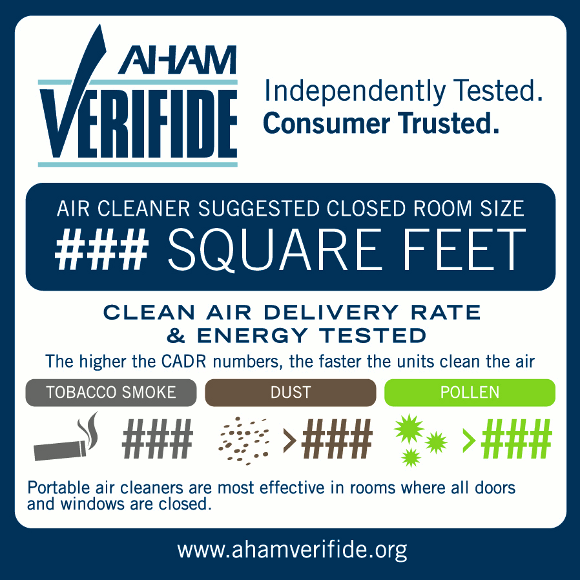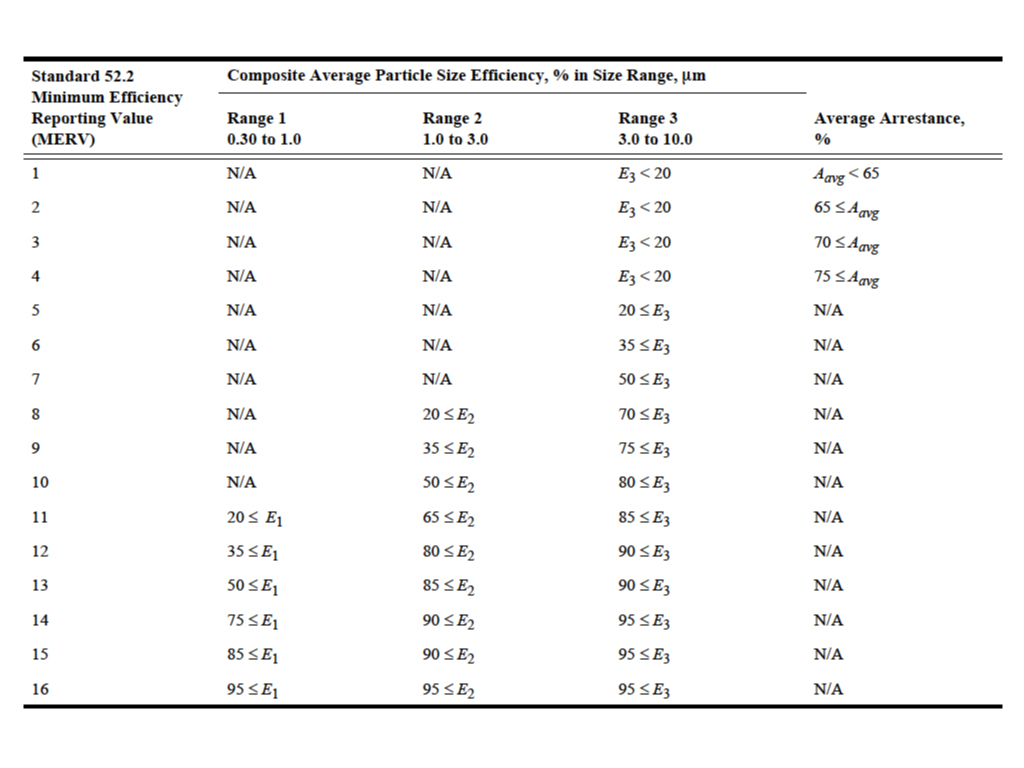Here at ActivePure, we are all about using our cutting-edge, active air purification to proactively neutralize pathogens, mold, and VOCs. We are often critical (justly, in our opinion) of attempts to remove these contaminants using passive technology—such as fibrous air filters—alone. However, the humble fibrous air filter still has an important role in creating better indoor air quality—namely, the removal of non-living particulate matter (PM) like dust, smoke, and dander. A number of our products pair ActivePure Technology with a true HEPA filter, thus addressing a fuller spectrum of airborne contaminants than either technology could on its own.
For this reason, we think consumers ought to know just as much about fibrous air filters as they do about active air purification. Here are 9 abbreviations (well, okay, 8 abbreviations and 1 regular vocabulary word) you may come across when trying to judge how well any given filter (or filter-based purifier) works.
ANSI
ANSI stands for the American National Standards Institute. It is a private organization which oversees the development of standards in many industries but does not develop industry standards itself. In other words, it is an organization that sets the standards for setting standards. Both ASHRAE and AHAM (see below) develop their testing methods with voluntary ANSI oversight.
ASHRAE
ASHRAE stands for the American Society of Heating, Refrigerating, and Air-Conditioning Engineers. ASHRAE is a professional trade organization aimed at advancing HVAC and refrigeration technology; this includes research and advocating for related legislation. ASHRAE issues guidelines and standards related to the testing and classification of air filters; it is from ASHRAE that we receive concrete definitions for MERV and arrestance(see below).
AHAM
AHAM stands for the Association of Home Appliance Manufacturers. AHAM is another professional trade organization with a focus on advocacy for—quite obviously—home appliance manufacturers. AHAM has developed a standardized method for testing certain types of portable air cleaners (see CADR below).
Arrestance
What is arrestance? The official definition of arrestance is “a measure of the ability of an air-cleaning device with efficiencies less than 20% in the size range of 3.0 to 10.0 [microns] to remove loading dust from test air.” This is measured by loading a synthetic test dust into an experimental chamber with a filter and subtracting the weight of dust in the air after it passes through the filter from the total weight of dust fed into the filter. Arrestance is then articulated as a percentage of the synthetic dust captured.
Arrestance is not a term that applies to every filter. It is only used to measure the effectiveness of the four lowest MERV classifications (see MERV below). These low-grade filters (also called coarse air cleaners) are used in HVAC equipment to collect the largest particles (i.e., particles 10 microns or above).
Bonus vocabulary word: Arrestance is closely related to dust holding capacity, which is “the total weight of the synthetic loading dust captured by the air-cleaning device over all of the incremental dust loading steps.” Again, this only applies to coarse air cleaners.
CADR
What is CADR? CADR stands for clean air delivery rate; the term can be used in two ways.

CADR in an informal sense means just what it sounds like—the amount of clean air delivered by a purification device, expressed in cubic meters per hour or cubic feet per minute. This informal CADR can be calculated for everything from a houseplant to the Beyond Guardian Air.
CADR in a more formal sense refers to a series of three numbers assigned to a portable air purifier during a very specific testing process set by AHAM. This CADR is defined by AHAM as “the rate of contaminant reduction in the test chamber when the unit is turned on, minus the rate of natural decay when the unit is not running, multiplied by the volume of the test chamber as measured in cubic feet.”
It is calculated by placing an air purifier in a 1008ft3 chamber and turned to maximum fan speed. The chamber is then filled with one of three contaminants (representing dust, tobacco smoke, or pollen). Since AHAM knows how quickly each contaminant breaks down on its own, they can subtract this number from how long the air purifier takes to clean the chamber. They then multiply this success times the 1008ft3 volume and divide by 60 to achieve the CADR rating for that contaminant. This process is repeated separately for each containment. The max CADR rating a machine can receive is 450 for dust or pollen and 400 for smoke.
Do you need to buy an air purifier with a CADR rating? Not necessarily: AHAM’s formal CADR rating only applies to residential air purifiers and only to portable units (i.e., not induct units or commercial purifiers). Also, most types of active purifiers—such as those which contain ActivePure Technology—are not tested by AHAM, since they operate on a completely different principle.
CFM
It is vital to note that CADR is different from the total amount of air which passes through a machine. This total amount of airflow is sometimes called its CFM or cubic feet per minute. For traditional filter-based air purifiers, AHAM recommends a machine’s CADR be 2/3rd of its CFM. Once again, this general rule does not necessarily apply to active purifiers, since active purifiers do not rely on air passing through their mechanism in order to be effective.
HEPA
HEPA stands for High Efficiency Particulate Air [Filter]. HEPA filters are those filters with a MERV classification (see MERV below) of 17 or above. According to the EPA, “This type of air filter can theoretically remove at least 99.97% of dust, pollen, mold, bacteria, and any airborne particles with a size of 0.3 microns (µm).” HEPA filters are usually highly pleated to increase their surface area, and thus their effectiveness.
You might occasionally come across the terms “HEPA-like filter” or “HEPA type filter.” This is a verbal sleight-of-hand. HEPA type and HEPA-like filters are *not* HEPA filters at all, but merely a lower grade of fibrous filters.(In fairness to marketing departments, consumers sometimes insist on HEPA filters even when such a high grade would impair the overall effectiveness of their system, so perhaps the motivation behind the creation of these terms is partially altruistic.) You will sometimes see HEPA filters referred to as “true HEPA” to distinguish them from “HEPA-like filters.”
We may recommend pairing ActivePure Technology with different filters, depending on your system's needs. In all cases where ActivePure Technology is paired with a filter in a portable unit, however, that filter is always a true HEPA filter.
 ASHRAE’s chart showing the effectiveness of each MERV classification
(below HEPA level) for each particle size.
ASHRAE’s chart showing the effectiveness of each MERV classification
(below HEPA level) for each particle size.
MERV
What is a MERV rating? MERV stands for “ Minimum Efficiency Reporting Value” and it is a measure of how well filters remove particles 10 microns in diameter or smaller. This is determined using a series of 72 separate tests (both when the filter is clean and when it is already loaded with dust) of 12 different particle sizes (grouped into three different ranges of four sizes each—see E1, E2, and E3 in the chart above). The lowest success rate for each of the 12 particle sizes is averaged for each range. The lowest of the three numbers is then used to determine a filter’s MERV rating.
For instance, a filter with an success rate of 84% in range E1 (MERV 14), of 98% in E2 (MERV 16) and 100% in E3 (MERV 17-20) would be classified as a MERV 14 filter, not a MERV 17 filter.
MERV rankings run from 1 to 20. Filters with a MERV ranking of 1 to 4 (less than 20% effective at removing PM10) are measured using arrestance instead (see arrestance above). Filters with a MERV classification 17 or greater are called HEPA filters (see HEPA above).
Micron
A micron, or micrometer, is a unit of measure equal to one millionth of a meter. It is abbreviated as μm (using the lowercase Greek letter mu paired with a lowercase m).
At the risk of stating the obvious, microns are very small. The naked eye can only see objects which are at least 40 microns in diameter. For comparison, the particulate matter which filters capture is usually smaller than 10 microns. Thus, most filters are not targeting the visible dust you can see, but the invisible dust which penetrates deeply into the lungs (or even into the bloodstream).
Want to learn more?
Fibrous air filters collect professional jargon as efficiently as they collect dust. We hope this untangling of acronyms will be helpful next time you are researching a filter to pair with the ActivePure Technology in your HVAC system (or for knowing just how good the HEPA filters in certain ActivePure portable units are).
Of course, rather than doing all this research, you can just ask the experts. To learn more about how different types of purifiers can best suit the needs of your business or organization, contact us today!



